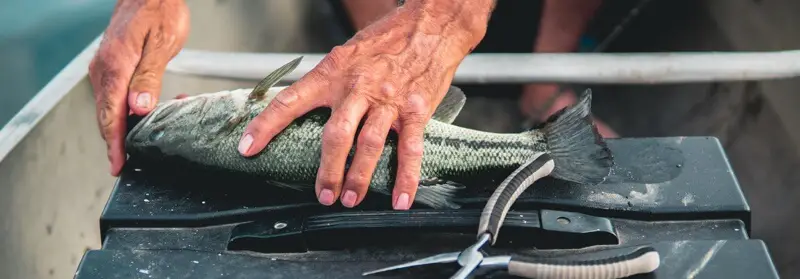Have you ever gone fishing, caught yourself a delicious bass, brought it home, and stuck it in the fridge, only to remember it a couple of weeks later? Well, if you’re like me, you definitely don’t want to waste good food, but how can you tell if the fish is still okay to eat or when it’s gone bad?
The best way to tell if a fish has “gone bad” is to smell it, look at it and feel it. When fish goes bad (off), it will develop a stronger fishy smell, which gradually becomes rancid. Off fish will have a milky or gray color. Its skin and flesh will also be soft to the touch without any elasticity.
Fish that has gone bad can cause serious problems if eaten. We need to make sure that any fish we catch or buy is properly stored, but how do we do this, and does cooking help preserve fish?
To Eat Or Not To Eat, Facts About Fish That Has Gone Bad
Ways to identify when a fish has gone off
The best tools for detection are right in your hands, quite literally!
By using our senses, we can quickly determine whether or not fish has gone bad (off).
- Smell
Whole or processed, when you take the suspect fish in question out of the fridge/freezer, the smell will be the first thing that gives it away.
Fish should have a mild to moderate “fishy” smell (a bit like the ocean or other water body it was caught in; seaweed, or even a bit of a muddy smell for the likes of catfish and other bottom feeders).
As the fish begins to decompose, the fishy smell increases in potency, eventually turning fetid/putrid and smelling like ammonia or rotting eggs/meat.
- Look
Whether the fish in question is in a whole state or cut into various pieces will play a role in which signs to look for in determining if it has gone bad or not. While you’re giving it a sniff, you should notice a few things about the way the fish looks:
Whole
When the fish is still whole, look at:
- The eyes – Fresh fish will have glistening eyes, black pupils, and the eye itself will “stick out” from the head.
Fish that is bad will have sunken eyes that are grey and dull, with creamy colored corneas.
- The gills – Fresh fish will have pink or red gills that are clean and slime-free.
Fish that is bad will have yellow or grey gills and potentially a slimy buildup.
- The state of the body – Fresh fish should look a bit like when you caught it. The body, scales and head should all look “healthy” and intact. When you cut the fish open, it should have white or light pink meat (depending on the species caught).
Fish that is bad will look sunken around the body, have a milky glossy coat forming over it, and the meat will have a blue or gray hue to it.
Processed
When a fish has been processed, it will depend a lot on the part you’re looking at, but in general, fillets from fresh fish will “shine or glisten” and should be pink or white.
The same milky glossy coating and blue/gray color should be looked for when identifying fish that has gone bad.
Take note of the bloodline (if present). In a healthy fish, it will appear red in color. If the fish has gone off, it will be a brown color.
- Touch
While perusing the fish, take note of how it feels.
A fresh fish will be firm to the touch and have hard scales.
A fish that has gone bad will feel slimy to the touch. As decomposition continues, there will be an increase in the slime buildup until the fish is slippery (this includes filets and other meat).
Furthermore, the skin of a fish that is going bad will be soft to the touch, easily comes loose from the flesh and scales, and lacks the elasticity to return to its original shape (where you depressed the skin with your fingers).
- Taste
The final test is a bit unpleasant, and hopefully, you would have picked up on a fish that has spoiled LONG before this, but once cooked and on the table, taking that first bite will be the deciding factor. If it tastes bad, the chances are it probably is (recopies aside). If there is any doubt, spit it out!
The Shelf-Life Of Fish

The “Shelf-Life” is another method that will contribute to determining whether a fish is still good to eat or not. A big factor influencing shelf life is whether the fish was store-bought and processed or freshly caught.
Store-bought, processed fish is relatively easy. They come with “sell-by“ and often times “use-by” dates on their packaging. Although not perfect, this is a helpful guide in determining if a fish will still be edible or not.
When fish are freshly caught, it is recommended to gut and clean them immediately then to store them in a fridge/freezer.
Furthermore, fresh fish should be consumed within 36 hours; however, if properly processed and refrigerated, you can still use the fish after two, maximum of three days.
When refrigerating, you should aim to keep the fish at or below 40 degrees Fahrenheit.
When freezing fish, the U.S. Department of Agriculture website states that it can be kept indefinitely in the freezer; however, it is recommended to use the fish within three to eight months of freezing. The freezing temperature is 0 degrees Fahrenheit.
Some factors influencing the shelf-life include:
- Practicing good and proper hygiene- prevents bacteria and other organisms from reducing the shelf-life of fish.
- Cleaning the fish properly before refrigeration/freezing.
- After being caught, how the fish was handled (was it dropped around and bruised, or was the skin damaged), and how long it was kept alive for.
- The temperatures the fish was exposed to after processing, during transport, etc.
- When refrigerating or freezing, make sure to use a good sealable container to prevent bacteria, etc., from spoiling the fish.
Other Methods Of Increasing The Shelf Life Of Fish
We have already looked at refrigerating and freezing as options to preserve the freshness of our fish, but are there other reliable methods?
Canning
Once caught and processed, pieces of fish meat are soaked in brine, placed in sterilized jars or cans, and then boiling the lot in a canner.
According to the U.S. Department of Agriculture, commercially canned fish is good for up to five years, while home canning is only good for one year.
Curing
The process of curing is done by either smoking or salting fish.
Before smoking, fish is soaked in brine, after which it is then placed over a source of smoke (generally a wood fire). Once smoked and vacuum packed, you have about two to three weeks. Alternatively, if you freeze the fish after smoking, you can keep it for up to three months.
When salting, you use a mixture of salt, sugar, and other spices rubbed all over the fish. Once salted up, place the fish in a refrigerator for three days. Afterward, the fish will last up to five days.
Cooking
The final method of “preserving” fish is to cook it. Although it won’t give you as long as the other methods, when used in conjunction with freezing or refrigeration, you will be able to keep cooked fish for five to six days in the fridge and between six to nine months in the freezer.
Although the U.S. Department of Agriculture only recommends a storage period of three months for frozen cooked fish.
Note: Once cooked, certain signs of decay will be more difficult to see. Namely, cooked fish that has gone bad won’t have a milky appearance and won’t develop the slimy layer.
Related Resources
- How Long Can Fish Live Out of Water?
- How Long Can You Keep Fish After Catching?
- Are Fish Mounts Made From Real Fish?
Conclusion
With these things in mind, the next time you open the fridge and spot last week’s “fish surprise,” remember to give it the smell, look and feel test to ensure that the fish doesn’t give you a nasty surprise!

